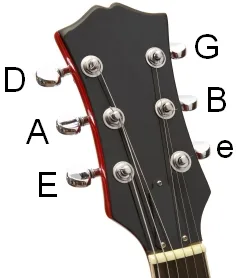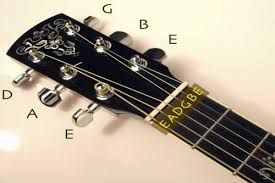Welcome to the world of guitar playing! If you’re just starting out and looking to learn some basic chords or play your favorite songs, you may have come across the term “standard tuning.” But what does it mean? And what key is standard tuning on a guitar?
In this article, I’ll answer these questions and more as we dive into the fundamentals of standard tuning. Whether you’re a beginner trying to grasp the basics or a seasoned player looking for a refresher, this guide has got you covered. So grab your guitar and let’s get started!
So, what key is standard tuning on a guitar?
Standard tuning on a guitar is in the key of E. This means that when all the strings are played open, without any fingers pressing down on the frets, it produces an E chord. The six strings on a guitar are tuned to the following notes: E-A-D-G-B-E. Each string has a different pitch and corresponds to a specific note on the musical scale.
Having this standard tuning makes it easier for beginners to learn chords and play songs in their original key. It also allows for consistency among musicians, as most songs are written and played using this tuning.
However, it is important to note that guitars can be tuned to different keys depending on personal preference or specific song requirements. Some common alternate tunings include Drop D (D-A-D-G-B-E) and Open G (D-G-D-G-B-D).
In summary, while standard tuning is in the key of E, there are other tunings available for guitar players to explore and experiment with. Ultimately, finding what works best for you will depend on your playing style and musical preferences.
Understanding the Concept of Standard Tuning on a Guitar
When you pick up a guitar, the way it sounds is largely determined by how it’s tuned. The most common tuning for a six-string guitar is known as standard tuning, where the strings are tuned to specific notes. Starting from the thickest string to the thinnest, they are tuned to E, A, D, G, B, and E. This arrangement creates a rich tapestry of sound that allows musicians to play many songs easily. Think of it as a roadmap; when your instrument is in tune with these notes, everything becomes more straightforward and enjoyable.
Standard tuning not only provides a foundation for playing but also enables players to learn chords and scales effectively. With this setup, you can form major, minor, and even 7th chords without too much hassle. It’s like having keys on a piano; once you know where they are located—in this case on your fretboard—you can explore countless musical avenues! Additionally, because so many songs are written with standard tuning in mind—be it rock or folk—it offers an immediate connection between aspiring guitarists and their favorite tunes. Embracing this concept makes learning both practical and fun!
Read also: yamaha guitar serial number lookup
Exploring How Each Guitar String in Standard Tuning Relates to Musical Notes
When you pick up a guitar, each string is like a pathway to discover beautiful music. In standard tuning, the six strings are tuned to specific notes: E, A, D, G, B, and e. This arrangement creates an exciting journey through sound. For instance, when you pluck the lowest string (the thick E), it resonates with deep vibrations that can feel powerful and grounding. Moving up to the A string introduces a slightly higher pitch that brings in warmth and richness into melodies.
As we explore further along the neck of the guitar, each note builds on this foundation. The D string continues this upward climb with its bright tone before transitioning into the softer G string. Then comes the B string; it’s often seen as delicate yet essential for creating harmonies in chords. Finally, we reach the highest e string—the one that sings sweetly at high pitches and adds sparkle to solos or leads in songs. Understanding how these strings relate not only enhances your playing but also opens doors for creativity. Each note interacts uniquely with others around it—a fascinating dance that allows musicians to express themselves freely through melody!
Identifying How To Tune Your Guitar Using the Standard Tuning Method
Tuning your guitar can feel like a daunting task at first, but once you understand the standard tuning method, it becomes much easier. In standard tuning, the strings are tuned to specific pitches: from the thickest string (the sixth string) to the thinnest (the first string), they are E, A, D, G, B, and E. You can start by ensuring your low E string is in tune with an electronic tuner or another reference pitch. Once this string resonates perfectly at its note, proceed to tune each subsequent string relative to it.
To tune with precision using our beloved standard method, follow these simple steps:
- A String: Play the fifth fret of the low E string; it should match the open A string.
- D String: Now play the fifth fret of your A string for an accurate D note against your open D string.
- G String: Again apply that same logic; play the fifth fret on your D for perfecting G tuning.
- B String: This time go back one fret and compare; use fourth fret on G for achieving a well-tuned B.
- E String: Lastly, match up by playing that fourth fret again on B to fine-tune your high E.
With practice and patience while applying this technique regularly—your musical journey will flourish!

Examining Different Techniques and Songs You Can Play in Standard Guitar Tuning
When diving into the world of guitar playing, standard tuning opens up a treasure trove of techniques and songs. One popular method is fingerpicking, where players pluck individual strings with their fingers instead of using a pick. This technique allows for beautiful melodies to intertwine with harmonies, creating rich soundscapes. Songs like “Blackbird” by The Beatles showcase this style perfectly, allowing you to explore intricate patterns while enjoying the joy of music creation. Another fascinating approach is strumming, which can add rhythm and energy to your performance; classic hits like “Wonderwall” by Oasis are fantastic starting points for anyone wanting to master various strumming patterns.
Additionally, you might consider experimenting with alternate picking or hammer-ons and pull-offs in standard tuning. These techniques not only enhance speed but also give depth to solos and riffs that captivate listeners’ attention. For instance, Jimi Hendrix’s “Purple Haze” utilizes these elements brilliantly—combining them creates a unique flair that’s instantly recognizable. As you practice these styles through different songs—like incorporating open chords in “Horse With No Name” by America—you’ll discover how versatile standard tuning can be! It truly serves as a foundation upon which countless musical journeys unfold.
You may also like: trombone essential elements
Conclusion: The Importance of Mastering Standard Tuning for Beginning Guitarists
Learning to play the guitar can be an exciting journey, and mastering standard tuning is a crucial first step for budding musicians. When you tune your guitar to the standard EADGBE, each string resonates beautifully with others, making it easier to create harmonious sounds. This tuning method sets the foundation for countless songs across genres. Imagine strumming a chord and hearing that perfect blend of notes! It’s like painting on a canvas where every stroke matters; if one string is off-key, it can throw everything out of balance.
Moreover, understanding standard tuning helps beginners develop essential skills in ear training and muscle memory. As players become familiar with how different chords sound together in this setup, they’ll find themselves more confident when exploring new songs or techniques. For example:
- Identifying melodies becomes simpler.
- Playing along with friends or recordings is much easier.
- The transition between different chords feels natural over time.
Embracing this fundamental aspect of guitar playing not only enhances enjoyment but also paves the way for complex musical expressions later on. Ultimately, having a solid grasp of standard tuning can make all the difference between struggling through notes and effortlessly creating beautiful music.

